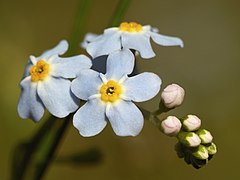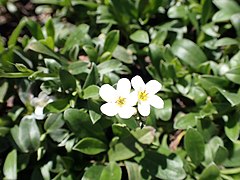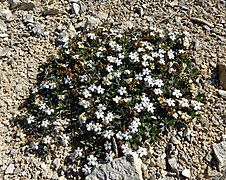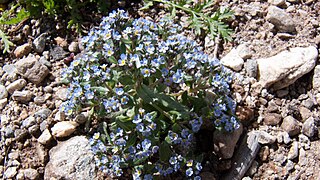
Myosotis pansa subsp. pansa, also known as the Waitakere forget-me-not, is a subspecies of flowering plant in the family Boraginaceae, endemic to the North Island of New Zealand. Lucy Moore described the variety M. petiolata var. pansa in 1961, and it was transferred to a subspecies of M. pansa by Heidi Meudt, Jessica Prebble, Rebecca Stanley and Michael Thorsen in 2013. Plants of this species of forget-me-not are perennial rosettes with ebracteate inflorescences and white corollas with exserted stamens.

Myosotis antarctica is a species of flowering plant in the family Boraginaceae, native to mainland New Zealand, Campbell Island and southern Chile. Joseph Dalton Hooker described the species in his 19th century work Flora Antarctica. Plants of this species of forget-me-not are perennial with a prostrate habit, bracteate inflorescences, and white or blue corollas. It is one of two native species of Myosotis in the New Zealand subantarctic islands, the other being M. capitata, which also has blue corollas.

Myosotis eximia is a species of flowering plant in the family Boraginaceae endemic to the North Island of New Zealand. The species was described by Donald Petrie. Plants of this species of forget-me-not are perennial and erect, and have ebracteate inflorescences with white corollas.

Myosotis mooreana is a species of flowering plant in the family Boraginaceae, described as being endemic to the South Island of New Zealand by Carlos Lehnebach in 2012, and synonymised with Myosotis australis in 2020. Plants of this species of forget-me-not are perennial rosettes with ebracteate inflorescences and white or yellow corollas with stamens that are fully included in the corolla tube or sometimes partly exserted.
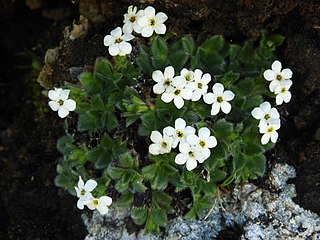
Myosotis retrorsa is a species of flowering plant in the family Boraginaceae, endemic to the South Island of New Zealand. Heidi Meudt, Jessica Prebble and Rowan Hindmarsh-Walls described the species. Plants of this species of forget-me-not are perennial with a prostrate habit, bracteate inflorescences, and white corollas.

Myosotis umbrosa is a species of flowering plant in the family Boraginaceae, endemic to the South Island of New Zealand. Heidi Meudt, Jessica Prebble and Michael Thorsen described the species. Plants of this species of forget-me-not are perennial with a prostrate habit, bracteate inflorescences, and white corollas.

Myosotis cheesemanii is a species of flowering plant in the family Boraginaceae, endemic to the South Island of New Zealand. Donald Petrie described the species in 1886. Plants of this species of forget-me-not are perennial rosettes with bracteate inflorescences and white corollas.
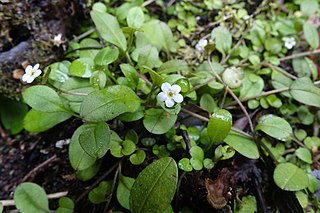
Myosotis tenericaulis is a species of flowering plant in the family Boraginaceae, endemic to New Zealand. Donald Petrie described the species in 1918. Plants of this species of forget-me-not are perennial rosettes with creeping, sprawling bracteate inflorescences and white corollas.
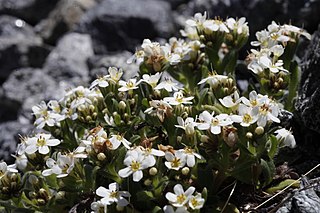
Myosotis lyallii is a species of flowering plant in the family Boraginaceae, endemic to New Zealand. Joseph Dalton Hooker described the species in 1853. Plants of this species of forget-me-not are perennial with a prostrate habit, bracteate or partially-bracteate inflorescences, and white corollas.

Myosotis brevis is a species of flowering plant in the family Boraginaceae, endemic to New Zealand. George Simpson and J.S. Thomson described M. pygmaea var. minutiflora in 1942, and Peter de Lange and John Barkla recognized it at species rank in 2010, as M. brevis. Plants of this species of forget-me-not are small and annual, with a prostrate habit, bracteate inflorescences, tiny white corollas, and brown or green leaves.

Myosotis goyeniisubsp. goyenii is a subspecies of flowering plant in the family Boraginaceae, endemic to southern South Island of New Zealand. Donald Petrie described the species M. goyenii in 1891. Plants of this subspecies of forget-me-not are perennial rosettes which form loose clumps, with ebracteate, erect inflorescences, and white corollas with partly exserted stamens.

Myosotis hikuwai is a species of flowering plant in the family Boraginaceae, endemic to the South Island of New Zealand. Heidi Meudt, Jessica Prebble and Geoff Rogers described M. hikuwai in 2022. Plants of this forget-me-not are spring annuals with bracteate and erect inflorescences, and small, white corollas with inserted stamens. The species is considered Threatened and known only from one population near Wānaka.

Myosotis pansa is a species of flowering plant in the family Boraginaceae, endemic to the North Island of New Zealand. Lucy Moore described the variety M. petiolata var. pansa in 1961, and it was raised to species level as M. pansa by Heidi Meudt, Jessica Prebble, Rebecca Stanley and Michael Thorsen in 2013. Plants of this species of forget-me-not are perennial rosettes with ebracteate inflorescences and white corollas and exserted anthers.
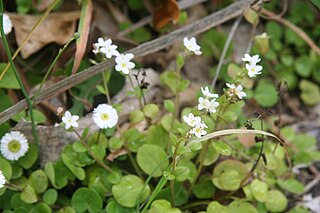
Myosotis pansa subsp. praeceps is a subspecies of flowering plant in the family Boraginaceae, endemic to the North Island of New Zealand. Lucy Moore described the variety M. petiolata var. pansa in 1961, and it was transferred to a subspecies of M. pansa by Heidi Meudt, Jessica Prebble, Rebecca Stanley and Michael Thorsen in 2013. Plants of this species of forget-me-not are perennial rosettes with partially bracteate inflorescences and white corollas with exserted stamens.

Myosotis saxatilis is a species of flowering plant in the family Boraginaceae, endemic to New Zealand. Donald Petrie described this species in 1918. Plants of this species of forget-me-not are perennial rosettes with ebracteate inflorescences and white corollas with stamens that are fully included in the corolla tube or sometimes partly exserted.
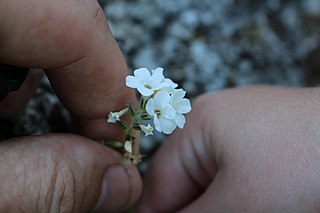
Myosotis lytteltonensis is a species of flowering plant in the family Boraginaceae and a synonym of Myosotis australis. It was first described as a variety of M. australis, considered endemic to the South Island of New Zealand, then raised to species status, and subsequently synonymised with Myosotis australis in 2020. Plants of this species of forget-me-not are perennial rosettes with ebracteate inflorescences and white or yellow corollas with stamens that are fully included in the corolla tube or sometimes partly exserted.

Myosotis amabilis is a species of flowering plant in the family Boraginaceae, endemic to New Zealand. Thomas Cheeseman described the species in 1906 based on specimens collected at Mt Hikurangi. Plants of this species of forget-me-not are perennial rosettes with ebracteate inflorescences and white corollas with stamens that are exserted.

Myosotis macrantha or the Bronze Forget-Me-Not is a species of flowering plant in the family Boraginaceae, endemic to the South Island of New Zealand. Joseph Dalton Hooker described the species as Exarrhena macrantha in 1864, and Thomas Cheeseman transferred it to the genus Myosotis in 1885. Plants of this species of forget-me-not are perennial rosettes with ebracteate inflorescences and yellow to dark purple corollas with stamens that are exserted.

Myosotis explanata is a species of flowering plant in the family Boraginaceae, endemic to high-elevation habitats in the South Island of New Zealand. Thomas Cheeseman described the species in 1906. Plants of this species of forget-me-not are perennial rosettes with ebracteate inflorescences and white corollas with stamens that are partly exserted, with the tips of the anthers only surpassing the scales.

Myosotis oreophila is a species of flowering plant in the family Boraginaceae, endemic to the South Island of New Zealand. Donald Petrie described the species in 1896. Plants of this species of forget-me-not are perennial rosettes with ebracteate inflorescences and white corollas with stamens that are partially exserted.



